Filipe Rodrigues
Climate Surrogates for Scalable Multi-Agent Reinforcement Learning: A Case Study with CICERO-SCM
Oct 09, 2025Abstract:Climate policy studies require models that capture the combined effects of multiple greenhouse gases on global temperature, but these models are computationally expensive and difficult to embed in reinforcement learning. We present a multi-agent reinforcement learning (MARL) framework that integrates a high-fidelity, highly efficient climate surrogate directly in the environment loop, enabling regional agents to learn climate policies under multi-gas dynamics. As a proof of concept, we introduce a recurrent neural network architecture pretrained on ($20{,}000$) multi-gas emission pathways to surrogate the climate model CICERO-SCM. The surrogate model attains near-simulator accuracy with global-mean temperature RMSE $\approx 0.0004 \mathrm{K}$ and approximately $1000\times$ faster one-step inference. When substituted for the original simulator in a climate-policy MARL setting, it accelerates end-to-end training by $>\!100\times$. We show that the surrogate and simulator converge to the same optimal policies and propose a methodology to assess this property in cases where using the simulator is intractable. Our work allows to bypass the core computational bottleneck without sacrificing policy fidelity, enabling large-scale multi-agent experiments across alternative climate-policy regimes with multi-gas dynamics and high-fidelity climate response.
Reproducibility in the Control of Autonomous Mobility-on-Demand Systems
Jun 09, 2025Abstract:Autonomous Mobility-on-Demand (AMoD) systems, powered by advances in robotics, control, and Machine Learning (ML), offer a promising paradigm for future urban transportation. AMoD offers fast and personalized travel services by leveraging centralized control of autonomous vehicle fleets to optimize operations and enhance service performance. However, the rapid growth of this field has outpaced the development of standardized practices for evaluating and reporting results, leading to significant challenges in reproducibility. As AMoD control algorithms become increasingly complex and data-driven, a lack of transparency in modeling assumptions, experimental setups, and algorithmic implementation hinders scientific progress and undermines confidence in the results. This paper presents a systematic study of reproducibility in AMoD research. We identify key components across the research pipeline, spanning system modeling, control problems, simulation design, algorithm specification, and evaluation, and analyze common sources of irreproducibility. We survey prevalent practices in the literature, highlight gaps, and propose a structured framework to assess and improve reproducibility. Specifically, concrete guidelines are offered, along with a "reproducibility checklist", to support future work in achieving replicable, comparable, and extensible results. While focused on AMoD, the principles and practices we advocate generalize to a broader class of cyber-physical systems that rely on networked autonomy and data-driven control. This work aims to lay the foundation for a more transparent and reproducible research culture in the design and deployment of intelligent mobility systems.
Spatio-Temporal Graph Neural Network for Urban Spaces: Interpolating Citywide Traffic Volume
May 07, 2025Abstract:Reliable street-level traffic volume data, covering multiple modes of transportation, helps urban planning by informing decisions on infrastructure improvements, traffic management, and public transportation. Yet, traffic sensors measuring traffic volume are typically scarcely located, due to their high deployment and maintenance costs. To address this, interpolation methods can estimate traffic volumes at unobserved locations using available data. Graph Neural Networks have shown strong performance in traffic volume forecasting, particularly on highways and major arterial networks. Applying them to urban settings, however, presents unique challenges: urban networks exhibit greater structural diversity, traffic volumes are highly overdispersed with many zeros, the best way to account for spatial dependencies remains unclear, and sensor coverage is often very sparse. We introduce the Graph Neural Network for Urban Interpolation (GNNUI), a novel urban traffic volume estimation approach. GNNUI employs a masking algorithm to learn interpolation, integrates node features to capture functional roles, and uses a loss function tailored to zero-inflated traffic distributions. In addition to the model, we introduce two new open, large-scale urban traffic volume benchmarks, covering different transportation modes: Strava cycling data from Berlin and New York City taxi data. GNNUI outperforms recent, some graph-based, interpolation methods across metrics (MAE, RMSE, true-zero rate, Kullback-Leibler divergence) and remains robust from 90% to 1% sensor coverage. On Strava, for instance, MAE rises only from 7.1 to 10.5, on Taxi from 23.0 to 40.4, demonstrating strong performance under extreme data scarcity, common in real-world urban settings. We also examine how graph connectivity choices influence model accuracy.
Deep Reinforcement Learning for Day-to-day Dynamic Tolling in Tradable Credit Schemes
Apr 10, 2025Abstract:Tradable credit schemes (TCS) are an increasingly studied alternative to congestion pricing, given their revenue neutrality and ability to address issues of equity through the initial credit allocation. Modeling TCS to aid future design and implementation is associated with challenges involving user and market behaviors, demand-supply dynamics, and control mechanisms. In this paper, we focus on the latter and address the day-to-day dynamic tolling problem under TCS, which is formulated as a discrete-time Markov Decision Process and solved using reinforcement learning (RL) algorithms. Our results indicate that RL algorithms achieve travel times and social welfare comparable to the Bayesian optimization benchmark, with generalization across varying capacities and demand levels. We further assess the robustness of RL under different hyperparameters and apply regularization techniques to mitigate action oscillation, which generates practical tolling strategies that are transferable under day-to-day demand and supply variability. Finally, we discuss potential challenges such as scaling to large networks, and show how transfer learning can be leveraged to improve computational efficiency and facilitate the practical deployment of RL-based TCS solutions.
Robo-taxi Fleet Coordination at Scale via Reinforcement Learning
Apr 09, 2025Abstract:Fleets of robo-taxis offering on-demand transportation services, commonly known as Autonomous Mobility-on-Demand (AMoD) systems, hold significant promise for societal benefits, such as reducing pollution, energy consumption, and urban congestion. However, orchestrating these systems at scale remains a critical challenge, with existing coordination algorithms often failing to exploit the systems' full potential. This work introduces a novel decision-making framework that unites mathematical modeling with data-driven techniques. In particular, we present the AMoD coordination problem through the lens of reinforcement learning and propose a graph network-based framework that exploits the main strengths of graph representation learning, reinforcement learning, and classical operations research tools. Extensive evaluations across diverse simulation fidelities and scenarios demonstrate the flexibility of our approach, achieving superior system performance, computational efficiency, and generalizability compared to prior methods. Finally, motivated by the need to democratize research efforts in this area, we release publicly available benchmarks, datasets, and simulators for network-level coordination alongside an open-source codebase designed to provide accessible simulation platforms and establish a standardized validation process for comparing methodologies. Code available at: https://github.com/StanfordASL/RL4AMOD
Diffusion-aware Censored Gaussian Processes for Demand Modelling
Jan 21, 2025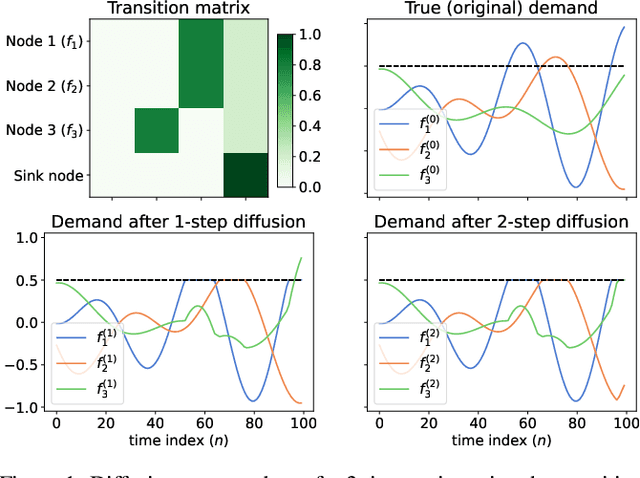
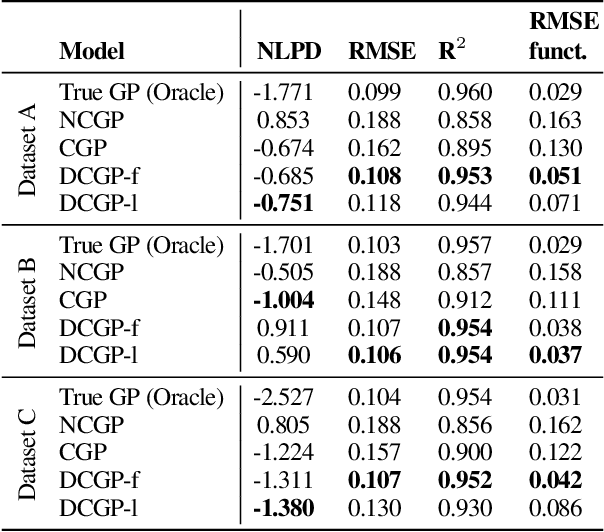
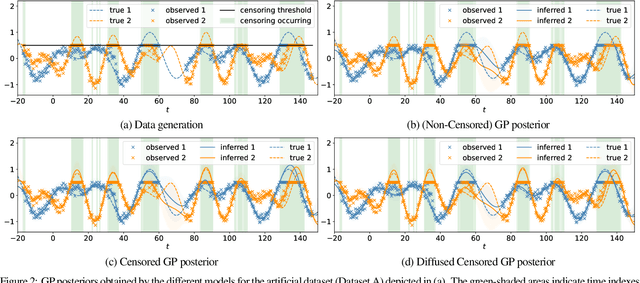
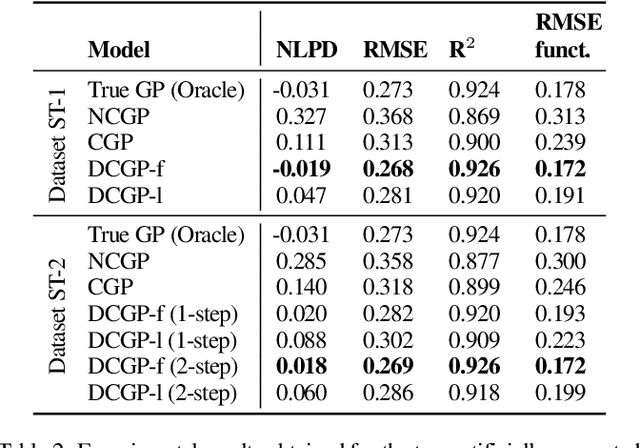
Abstract:Inferring the true demand for a product or a service from aggregate data is often challenging due to the limited available supply, thus resulting in observations that are censored and correspond to the realized demand, thereby not accounting for the unsatisfied demand. Censored regression models are able to account for the effect of censoring due to the limited supply, but they don't consider the effect of substitutions, which may cause the demand for similar alternative products or services to increase. This paper proposes Diffusion-aware Censored Demand Models, which combine a Tobit likelihood with a graph diffusion process in order to model the latent process of transfer of unsatisfied demand between similar products or services. We instantiate this new class of models under the framework of GPs and, based on both simulated and real-world data for modeling sales, bike-sharing demand, and EV charging demand, demonstrate its ability to better recover the true demand and produce more accurate out-of-sample predictions.
Offline Hierarchical Reinforcement Learning via Inverse Optimization
Oct 10, 2024



Abstract:Hierarchical policies enable strong performance in many sequential decision-making problems, such as those with high-dimensional action spaces, those requiring long-horizon planning, and settings with sparse rewards. However, learning hierarchical policies from static offline datasets presents a significant challenge. Crucially, actions taken by higher-level policies may not be directly observable within hierarchical controllers, and the offline dataset might have been generated using a different policy structure, hindering the use of standard offline learning algorithms. In this work, we propose OHIO: a framework for offline reinforcement learning (RL) of hierarchical policies. Our framework leverages knowledge of the policy structure to solve the inverse problem, recovering the unobservable high-level actions that likely generated the observed data under our hierarchical policy. This approach constructs a dataset suitable for off-the-shelf offline training. We demonstrate our framework on robotic and network optimization problems and show that it substantially outperforms end-to-end RL methods and improves robustness. We investigate a variety of instantiations of our framework, both in direct deployment of policies trained offline and when online fine-tuning is performed.
Large-Scale Demand Prediction in Urban Rail using Multi-Graph Inductive Representation Learning
Aug 28, 2024Abstract:With the expansion of cities over time, URT (Urban Rail Transit) networks have also grown significantly. Demand prediction plays an important role in supporting planning, scheduling, fleet management, and other operational decisions. In this study, we propose an Origin-Destination (OD) demand prediction model called Multi-Graph Inductive Representation Learning (mGraphSAGE) for large-scale URT networks under operational uncertainties. Our main contributions are twofold: we enhance prediction results while ensuring scalability for large networks by relying simultaneously on multiple graphs, where each OD pair is a node on a graph and distinct OD relationships, such as temporal and spatial correlations; we show the importance of including operational uncertainties such as train delays and cancellations as inputs in demand prediction for daily operations. The model is validated on three different scales of the URT network in Copenhagen, Denmark. Experimental results show that by leveraging information from neighboring ODs and learning node representations via sampling and aggregation, mGraphSAGE is particularly suitable for OD demand prediction in large-scale URT networks, outperforming reference machine learning methods. Furthermore, during periods with train cancellations and delays, the performance gap between mGraphSAGE and other methods improves compared to normal operating conditions, demonstrating its ability to leverage system reliability information for predicting OD demand under uncertainty.
Bayesian Active Learning for Censored Regression
Feb 19, 2024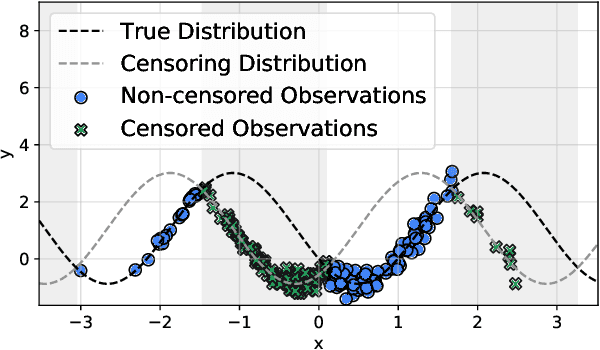

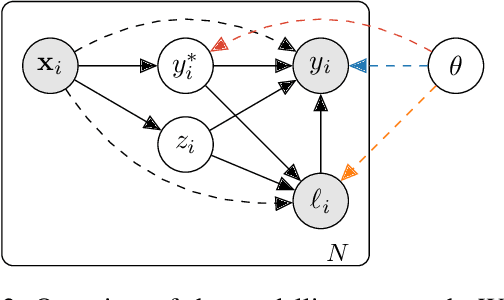

Abstract:Bayesian active learning is based on information theoretical approaches that focus on maximising the information that new observations provide to the model parameters. This is commonly done by maximising the Bayesian Active Learning by Disagreement (BALD) acquisitions function. However, we highlight that it is challenging to estimate BALD when the new data points are subject to censorship, where only clipped values of the targets are observed. To address this, we derive the entropy and the mutual information for censored distributions and derive the BALD objective for active learning in censored regression ($\mathcal{C}$-BALD). We propose a novel modelling approach to estimate the $\mathcal{C}$-BALD objective and use it for active learning in the censored setting. Across a wide range of datasets and models, we demonstrate that $\mathcal{C}$-BALD outperforms other Bayesian active learning methods in censored regression.
Arrival Time Prediction for Autonomous Shuttle Services in the Real World: Evidence from Five Cities
Jan 10, 2024Abstract:Urban mobility is on the cusp of transformation with the emergence of shared, connected, and cooperative automated vehicles. Yet, for them to be accepted by customers, trust in their punctuality is vital. Many pilot initiatives operate without a fixed schedule, thus enhancing the importance of reliable arrival time (AT) predictions. This study presents an AT prediction system for autonomous shuttles, utilizing separate models for dwell and running time predictions, validated on real-world data from five cities. Alongside established methods such as XGBoost, we explore the benefits of integrating spatial data using graph neural networks (GNN). To accurately handle the case of a shuttle bypassing a stop, we propose a hierarchical model combining a random forest classifier and a GNN. The results for the final AT prediction are promising, showing low errors even when predicting several stops ahead. Yet, no single model emerges as universally superior, and we provide insights into the characteristics of pilot sites that influence the model selection process. Finally, we identify dwell time prediction as the key determinant in overall AT prediction accuracy when autonomous shuttles are deployed in low-traffic areas or under regulatory speed limits. This research provides insights into the current state of autonomous public transport prediction models and paves the way for more data-informed decision-making as the field advances.
 Add to Chrome
Add to Chrome Add to Firefox
Add to Firefox Add to Edge
Add to Edge